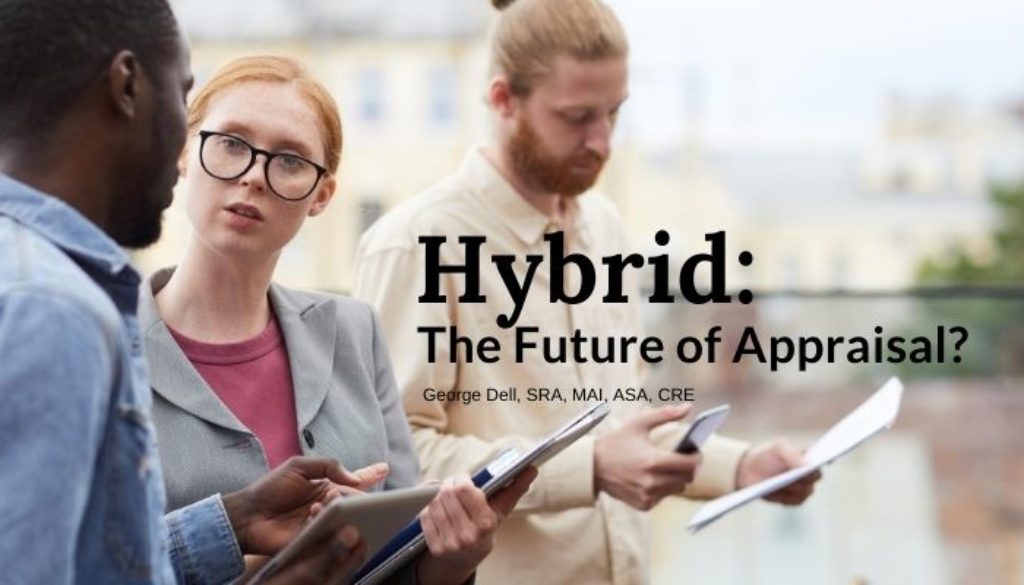Hairy scary hybrid parry. Let’s look deeper, now that we seem to be away from the original hype.
When this thing first came up from the GSEs (FannieMae and FreddieMac), a hybrid appraisal was narrowly defined. Basically, it separated the desk job from the field job. I was even in a room once where the (mostly residential) appraisers were asked if some would prefer to be just field people, or others would prefer to just sit at a desk and do analysis. I was surprised that most preferred one or the other. (I like doing both – I like the variety.)
The “hidden factor” may be that the GSEs and banks would love to have appraisers (or others) collect and improve data — while automated algorithmic programmatic whizbangs would do the rest. The improved data is collected and computated. Faster, cheaper, and under better control of the users. (You want to read my earlier earlier thoughts on hybrid appraisal? Start Here)
For this discussion, let’s include this ‘hidden’ aspect of what we called hybrid appraisals. So, we have a: data collection person, local (appraiser) analysis, and central (GSE) analysis.
As many of you know, I have long suggested that if appraisers become more skilled, we will do better.
Here is the problem, from the viewpoint of the collateral investor . . . (Can you do that for a second?) What does the lender want? The lender wants to know what is the risk of loss, and pay as little for this information as possible. Fast is good too!
How can computation skills help? Let’s compare: AVMs are secret algorithms. But they are fast and cheap. They are suitable where the lender already knows there is low risk (like a low loan amount). Comes the appraiser … Appraisals are subjective algorithms. Appraisers use “good judgment” to pick a few comps, use judgment and “support” for adjustments. And judgment to reconcile the comps and “three approaches.”
Why do the GSEs want to do “central analysis”? Its faster, cheaper, and less expensive. The reasoning is that if they can just get appraisers (or others) to improve the data, all will be well. They can use all the data, the ideal amount. Not just 4 or 5 judgment comps. Several algorithms can do a better job of delineating data (comps) than can the subjective picking of comps. Three simple algorithms do a better job of prediction (estimating adjustments). Better than ‘supporting’ an appraiser opinion. And the objective nature of the data selection and the predictives make it possible to calculate a risk score! Just what they wanted in the first place!
So. From that viewpoint . . . Why would the client want an opinion of what they don’t really need, instead of an analytic result of what they really need? Why?
Is there any hope for the appraisal profession? Not this way. Not with 1930’s appraisal process. It was wonderful and cutting edge and scientific and analytic then. It was great for difficult data. My time when I became an appraiser was mostly collecting data. Making phone calls. Trading comps with my fellows. Chapter meetings. The SREA and AIREA were king. To belong meant acceptance and fellowship and data. Good data. The best available.
So why would a GSE or lender client want someone to personally analyze the data? It is simple. Two reasons: 1) to provide preliminary help with the decision of what level of risk there is, and 2) to improve the data and make needed modeling decisions on the path of analysis. Simple.
Who can do this? Easy. The Asset Analyst who can apply modern data science. This is why we teach Stats, Graphs, and Data Science. This is the why of this weekly blog. This is why we have the paid subscription TAAR – The Asset Analyst Report. This is why we support the Community of Asset Analysts — a small, but growing group of appraisers who help each other, to learn, to encourage, and to believe that there is, and will continue to be a need for people who have the skills of appraisers, and principles of data science in a technology-shaped world. Join us.
